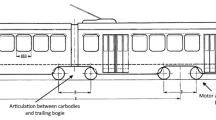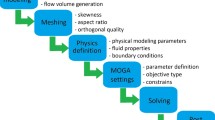Abstract
Optimal design parameter combination and transmission optimization for plane-generated enveloping toroid hourglass worm drive are proposed. The modeling frame and mathematical model of the worm were constructed first to provide a perfect transmission. Then, the mathematical representations of transmission performance, including lubrication angle, induced normal curvature, and length of meshing line for worm drive, were derived according to differential geometry and coordinate transformation approach. In addition, the influence of various design parameters on transmission performance was associated with main parameters, and the influence of the main parameters on transmission was evaluated. Next, a multivariate transmission optimization considering lubrication effect, bearing capacity and contact strength was conducted in view of the whole meshing cycle. The optimal global solution of the multivariate optimization model was also evaluated using a genetic algorithm. Calculation and experimental results indicated the optimization study was in good agreement with experimental results. Finally, the comprehensive transmission performance of the worm drive has an increase of 9.2 %.
Similar content being viewed by others
Abbreviations
- Rot z (-π/2) :
-
Coordinate transformation matrix rotates around z-axis
- α σ :
-
Lubrication angle
- σ H :
-
Hertzian stress
- B ca :
-
Contact load per unit meshing line
- Z E :
-
Coefficient of elastic influence
- k σ :
-
Induced normal curvature of worm drive
- Ψ :
-
Bound function that avoids interference and undercut
- L j :
-
Length of meshing lines of worm
- k 1 :
-
Coefficient of base circle of tool rest (reference circle of worm wheel)
- k 2 :
-
Coefficient of reference circle of worm
- Mα σ :
-
Average lubrication angle of all meshing points
- Mk σ :
-
Average induced normal curvature
- ML :
-
Average length of all meshing lines
- B b :
-
Bearing capacity before optimization
- B a :
-
Bearing capacity after optimization
- L Tb :
-
Average lubrication performance before optimization
- L Ta :
-
Average lubrication performance after optimization
References
Z. Liu, H. Lu, S. J. Wang and G. M. Yu, Digitization modeling and CNC machining for cone-generated double-enveloping worm drive, Internetionel Journal of Advanced Manufacturing Technology, 95 (2018) 3393–3412.
Y. Jie, H. T. Li, C. J. Rui, W. J. Wei and X. Z. Dong, A method to generate the spiral flutes of an hourglass worm gear hob, Journal of Mechanical Design, 140(6) (2018) 063301–12.
A. H. Falah, M. A. Alfares and A. H. Elkholy, Localised tooth contact analysis of single envelope worm gears with assembly errors, International Journal of Advanced Manufacturing Technology, 68 (2013) 2057–2070.
K. Kawasaki and I. Tsuji, Machining method of large-sized cylindrical worm gears with Niemann profiles using CNC machining center, International Journal of Advanced Manufacturing Technology, 104(9–12) (2019) 3717–3729.
Y. S. Zhou, S. H. Wang, L. M. Wang, J. Y. Tang and Z. Z. Chen, CNC milling of face gears with a novel geometric analysis, Mechanism and Machine Theory, 9 (2019) 46–65.
C. F. Huai and Y. P. Zhao, Meshing theory and tooth profile geometry of toroidal surface enveloping conical worm drive, Mechanism and Machine Theory, 134 (2019) 476–498.
K. He, G. L. Li and X. G. Li, The second envelope method of point-vector and its application on worm wheel grinding modified gear, International Journal of Advanced Manufacturing Technology, 88(9–12) (2017) 3175–3184.
S. Berbinschi, V. Teodor and N. Oancea, 3D graphical method for profiling tools that generate helical surface, International Journal of Advanced Manufacturing Technology, 60(5–8) (2012) 505–512.
Y. Z. Wang, Z. Lan, L. W. Hou, X. M. Chu and Y. Y. Yin, An efficient honing method for face gear with tooth profile modification, International Journal of Advanced Manufacturing Technology, 90 (2017) 1155–1163.
I. Dudás, The extension of the general mathematical model developed for helicoidal surfaces to the whole system of manufacturing technology and production geometry (ProMAT), International Journal of Advanced Manufacturing Technology, 86 (2016) 1557–1572.
Z. Liu, H. Lu, G. M. Yu and S. J. Wang, A novel CNC machining method for enveloping surface, International Journal of Advanced Manufacturing Technology, 85(1–4) (2016) 779–790.
Z. Liu, H. Lu, G. M. Yu and Z. Y. Hu, Digital entity modeling of planar double-enveloping torus worm pair, Computer Integrated Manufacturing Systems, 23(4) (2017) 1538–1551.
X. Q. Deng, J. Wang, S. K. Wang, G. He and Y. C. Liu, Theory and experiment study of anti-backlash single- and doubleroller enveloping hourglass worm gear, Journal of Mechanical Engineering, 3 (2020) 88–95.
G. Li, Z. H. Wang and A. Kubo, The modeling approach of digital real tooth surfaces of hypoid gears based on non-geometric-feature segmentation and interpolation algorithm, International Journal of Precision Engineering and Manufacturing, 17(3) (2016) 281–292.
J. K. Li, Z. X. Liu and C. Zhang, Analysis on isothermal elastohydrodynamic lubrication performance of inclined doubleroller enveloping hourglass worm drive, Journal of Xi’an Jiaotong University, 51(5) (2017) 88–94.
K. J. Sharif, H. P. Evans, R. W. Snidle, D. Barnett and I. M. Egorov, Effect of elastohydrodynamic film thickness on a wear model for worm gears, Journal of Engineering Tribology, 220(3) (2006) 295–306.
A. H. Falah and A. H. Elkholy, Load sharing and stress analysis of single enveloping worm gearing considering transmission errors, International Journal of Advanced Manufacturing Technology, 37(3–4) (2008) 211–220.
Y. Chen, G. F. Yin and Y. H. Chen, Meshing performance analyses of variable tooth thickness involute gear enveloping hourglass worm drives, China Mechanical Engineering, 23 (2019) 2798–2808.
A. H. Falah, M. A. Alfares and A. H. Elkholy, Localised tooth contact analysis of single envelope worm gears with assembly errors, International Journal of Advanced Manufacturing Technology, 68(9–12) (2013) 2057–2070.
F. L. Litvin and A. Fuentes, Gear Geometry and Applied Theory, Second Edition, Cambridge University Press (2004).
N. Saravanakumar, M. L. Jothi Saravanan, K. E. Barathkumar, K. Gokula Kannan and R. Karthikeyan, Development and testing of nano particulate lubricant for worm gear application, Journal of Mechanical Science and Technology, 33(4) (2019) 1785–1791.
Q. Wen, Q. G. Du and X. C. Zhai, An analytical method for calculating the tooth surface contact stress of spur gears with tip relief, International Journal of Mechanical Sciences, 151 (2019) 170–180.
A. Fuentes-Aznar, R. Ruiz-Orzaez and I. Gonzalez-Perez, Comparison of spur, helical and curvilinear gear drives by means of stress and tooth contact analyses, Meccanica, 52 (2017) 1721–1738.
X. Z. Dong, Design and Modification of Hourglass Worm Gearing, China Machine Press, Beijing (2004).
X. Y. Guan and C. Guo, Sharing pattern feature selection using multiple improved genetic algorithms and its application in bearing fault diagnosis, Journal of Mechanical Science and Technology, 33(1) (2019) 129–138.
J. H. Jeong and S. H. Kim, Optimization of thick wind turbine airfoils using a genetic algorithm, Journal of Mechanical Science and Technology, 32(7) (2018) 3191–3199.
Acknowledgments
The authors would like to acknowledge the support of the National Natural Science Foundation of China (No. 51675393), Hubei Province Key Science Foundation of China (No. D20192903, 2021BGE023) and Huanggang Science Foundation of China (No. XQYF2020000031). The authors would also like to express their acknowledgment to the reviewers and editors for their insightful comments and suggestions.
Author information
Authors and Affiliations
Corresponding author
Additional information
Zhi Liu works as a Professor at Huang-gang Normal University. He received his Ph.D. at Wuhan University of Technology in China. His research interests include digital design and manufacture of complicated transmission mechanisms and systems.
Hong Lu works as a Professor at Wuhan University of Technology. She received her Ph.D. at Wuhan University of Technology in China. Her research interests include CAD, CAM, and control of mechanical component and equipment.
Qingmeng Wang is a Lecturer of Huanggang Normal University. He received his Ph.D. in Materials Science and Engineering at Wuhan University of Technology. His research interests include new energy devices, solar thermal power generation, and alloy materials.
Zhangjie Li is a Ph.D. candidate at the School of Mechanical and Electrical Engineering, Wuhan University of Technology. He received his Master’s degree in Wuhan University of Technology, China. His research interests include mechanical dynamics and systems monitoring and control.
Qianju Cheng is a Lecturer of Huang-gang Normal University. He received his Ph.D. in Mechanical Engineering from Harbin Engineering University. His research interests include nonlinear vibration, energy harvesting, and intelligent manufacturing.
Rights and permissions
About this article
Cite this article
Liu, Z., Lu, H., Wang, Q. et al. Meshing analysis and optimization for plane-generated enveloping toroid hourglass worm drive. J Mech Sci Technol 35, 3069–3080 (2021). https://doi.org/10.1007/s12206-021-0629-6
Received:
Revised:
Accepted:
Published:
Issue Date:
DOI: https://doi.org/10.1007/s12206-021-0629-6




